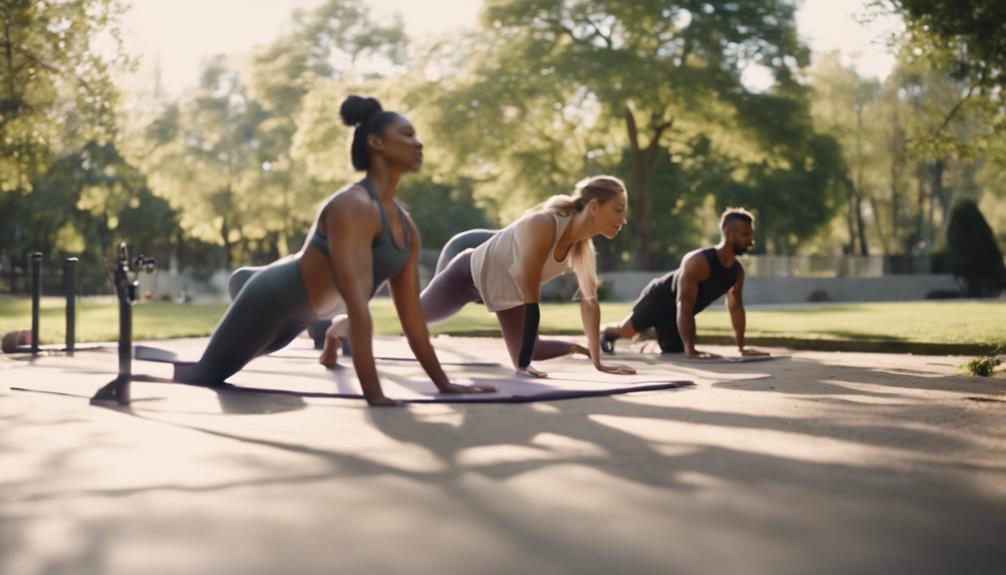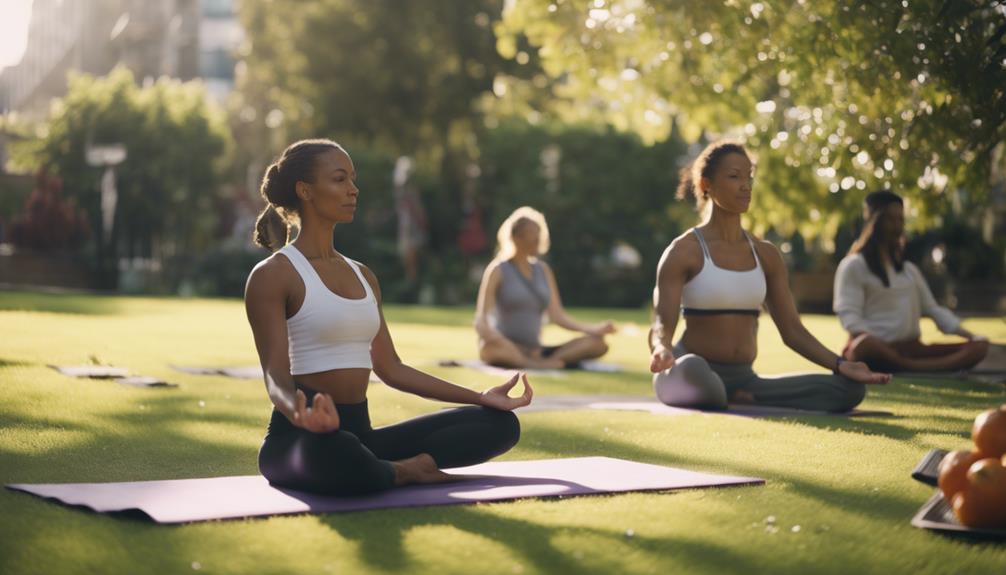To achieve a healthy lifestyle, incorporate a variety of exercises for optimal fitness. Strive for a minimum of 150 minutes of aerobic activities, such as brisk walking or cycling, per week to support your heart health. Make sure to also engage in strength training twice weekly to preserve muscle mass. Flexibility exercises like yoga can enhance mobility and reduce tension. Additionally, include balance exercises like tai chi to improve coordination and decrease the risk of falls. By integrating these different routines, you are laying the foundation for overall well-being. There is plenty more to discover about effective routines tailored to your lifestyle and objectives!
Key Takeaways
- Engage in at least 150 minutes of aerobic exercise weekly to boost heart health and reduce chronic disease risks.
- Incorporate strength training for all major muscle groups at least twice a week to maintain muscle mass and support metabolism.
- Add flexibility workouts like yoga or stretching to enhance range of motion and relieve muscle tension.
- Practice balance exercises such as tai chi to improve coordination and reduce the risk of falls, especially in older adults.
Top Exercises for Fitness
When it comes to boosting your fitness, incorporating a mix of aerobic exercises, strength training, flexibility workouts, balance exercises, and high-intensity interval training can make a notable difference in your overall health.
Start with aerobic exercises like brisk walking or swimming for at least 150 minutes weekly. These cardiovascular workouts considerably improve your health by enhancing heart health and reducing chronic disease risks.
Next, include strength training at least twice a week to target all major muscle groups. This not only helps maintain muscle mass but also supports your metabolism.
Don't forget about flexibility workouts, such as yoga or stretching, which improve your range of motion and alleviate muscle tension.
Incorporate balance exercises, like tai chi or standing on one leg, to enhance coordination and reduce fall risk, especially as you age.
Finally, high-intensity interval training (HIIT) can be a game-changer. By alternating between bursts of intense activity and recovery, you maximize calorie burn in shorter sessions, fitting perfectly into your fitness plan.
Regular exercise that includes these elements guarantees a well-rounded approach to improving your health and fitness.
Key Benefits of Regular Exercise
Regular exercise offers a multitude of benefits that can greatly enhance your overall health and well-being. By incorporating regular physical activity into your routine, you can experience significant improvements in various aspects of your life.
Here are three key benefits:
- Cardiovascular Health: Engaging in exercise strengthens your heart and improves blood circulation, reducing the risk of heart disease and stroke. This leads to lower blood pressure and better overall heart function.
- Weight Management: Regular physical activity plays an essential role in maintaining a healthy weight. Just 150 minutes of moderate-intensity exercise per week can help you manage your weight effectively and promote fat loss.
- Mental Health and Cognitive Function: Exercise releases endorphins, which can alleviate anxiety and depression symptoms, boosting your mood. Furthermore, consistent physical activity has been linked to improved cognitive function, helping you maintain memory and combat age-related decline.
With these health benefits, you'll not only improve muscle strength and bone density but also enhance your balance and overall quality of life.
Essential Components of a Routine

Incorporating essential components into your fitness routine guarantees a balanced approach to achieving ideal health and well-being.
Start with aerobic fitness; the CDC recommends at least 150 minutes of moderate-intensity activities each week to promote heart health. You can engage in activities like brisk walking, cycling, or swimming to meet this goal.
Next, include strength training to enhance muscle and bone strength. Aim to work all major muscle groups at least twice a week using resistance bands or weights at your local health club.
Core exercises are also crucial; incorporate moves like planks and bridges to boost stability and coordination, helping to prevent back injuries.
Don't overlook balance training, especially if you're older. Activities like tai chi or simply standing on one leg can greatly reduce fall risk.
Finally, prioritize flexibility; stretch regularly to improve your joint range of motion and ease muscle tension.
Incorporating these components— aerobic fitness, strength training, core exercises, balance training, and flexibility—ensures a thorough routine that supports your overall fitness and health goals.
Overcoming Exercise Challenges
Overcoming exercise challenges often starts with setting realistic goals that keep you motivated and focused on your progress. When you establish achievable fitness goals, you create a clear pathway to success that helps you overcome barriers.
Here are three strategies to enhance your fitness journey:
- Incorporate Engaging Activities: Choose exercises you enjoy, whether it's dancing, swimming, or hiking. This will keep your exercise plan enjoyable and reduce burnout.
- Utilize Online Resources: Explore various online resources and videos for guidance. They can provide structure and inspiration, helping you stay committed to your fitness goals, even when challenges arise.
- Join Group Classes or Find a Workout Partner: Engaging in social activities boosts accountability. Group classes or working out with a partner create a support system that can motivate you to push through obstacles.
Additionally, don't hesitate to explore adaptive exercises tailored to your specific health concerns or limitations. These modifications can make activities more accessible and enjoyable, ensuring you stay active and healthy.
With the right mindset and resources, you can conquer any exercise challenge that comes your way!
Guidelines for Effective Workouts

To achieve a healthy lifestyle, it's important to follow clear guidelines for effective workouts that maximize your fitness efforts. Aim for at least 150 minutes of moderate-intensity aerobic activity each week, or 75 minutes of vigorous-intensity exercise. This not only boosts your cardiovascular benefits but also enhances your endurance.
Incorporate muscle-strengthening activities targeting all major muscle groups on two or more days per week. This approach improves your overall fitness and helps prevent injuries. Don't forget to include flexibility and balance exercises, like yoga or tai chi, to enhance joint range of motion and reduce fall risks, especially if you're older.
To keep progressing, utilize the principle of progressive overload. Gradually increase the intensity and duration of your workouts to continuously challenge your body and avoid plateaus.
A well-rounded routine that includes cardio, strength training, and flexibility workouts will keep you engaged and motivated.
Frequently Asked Questions
What Is the Best Exercise to Get Fit?
To get fit, you should mix aerobic exercises, strength training, and flexibility workouts. Aim for a balanced routine that keeps you engaged and challenges your body, ensuring you maintain consistency for the best results.
What Is the Best Type of Exercise for Health?
Oh sure, if you're aiming for health, just sit and binge-watch! But really, mixing aerobic, strength, and flexibility exercises keeps you fit. Aim for variety; your body'll thank you with better health and energy!
What Are the Exercise Activities for a Healthy Lifestyle?
To maintain a healthy lifestyle, you should engage in aerobic activities like walking or swimming, incorporate strength training, practice flexibility exercises, and consider enjoyable options like dancing or HIIT for variety and motivation.
What Should You Do Exercise in Order to Keep Fit and Healthy?
To stay fit and healthy, you should engage in aerobic activities, strength training, core workouts, balance exercises, and flexibility routines. Aim for variety to keep your body strong, agile, and resilient against injuries.
What Are Some Effective Routines for Improving Health and Fitness?
Incorporating regular exercise for better health into your daily routine can be highly effective for improving overall fitness. Simple activities like walking, jogging, or cycling can significantly boost cardiovascular health. Strength training exercises also help build muscle and increase metabolism, while yoga and stretching can improve flexibility and reduce stress.
Conclusion
Incorporating these exercises into your daily routine is like planting seeds in a garden; with care and consistency, you'll watch your fitness flourish.
Embrace the benefits of regular movement, tackle any hurdles that come your way, and remember to nurture your body with balance.
As you commence on this journey, you'll find that each workout is a step toward a vibrant, healthier you.
So go ahead, lace up those shoes, and let your transformation begin!










